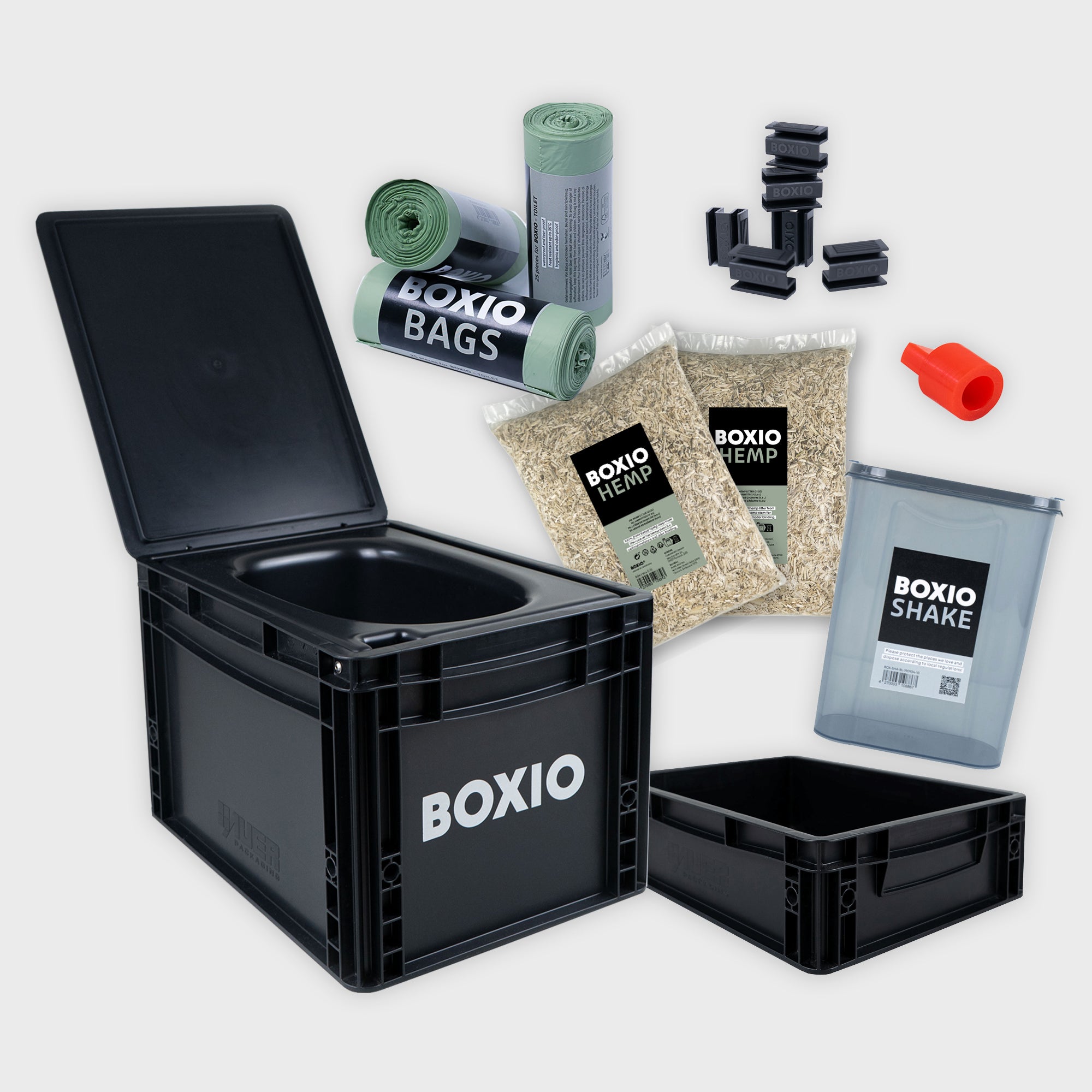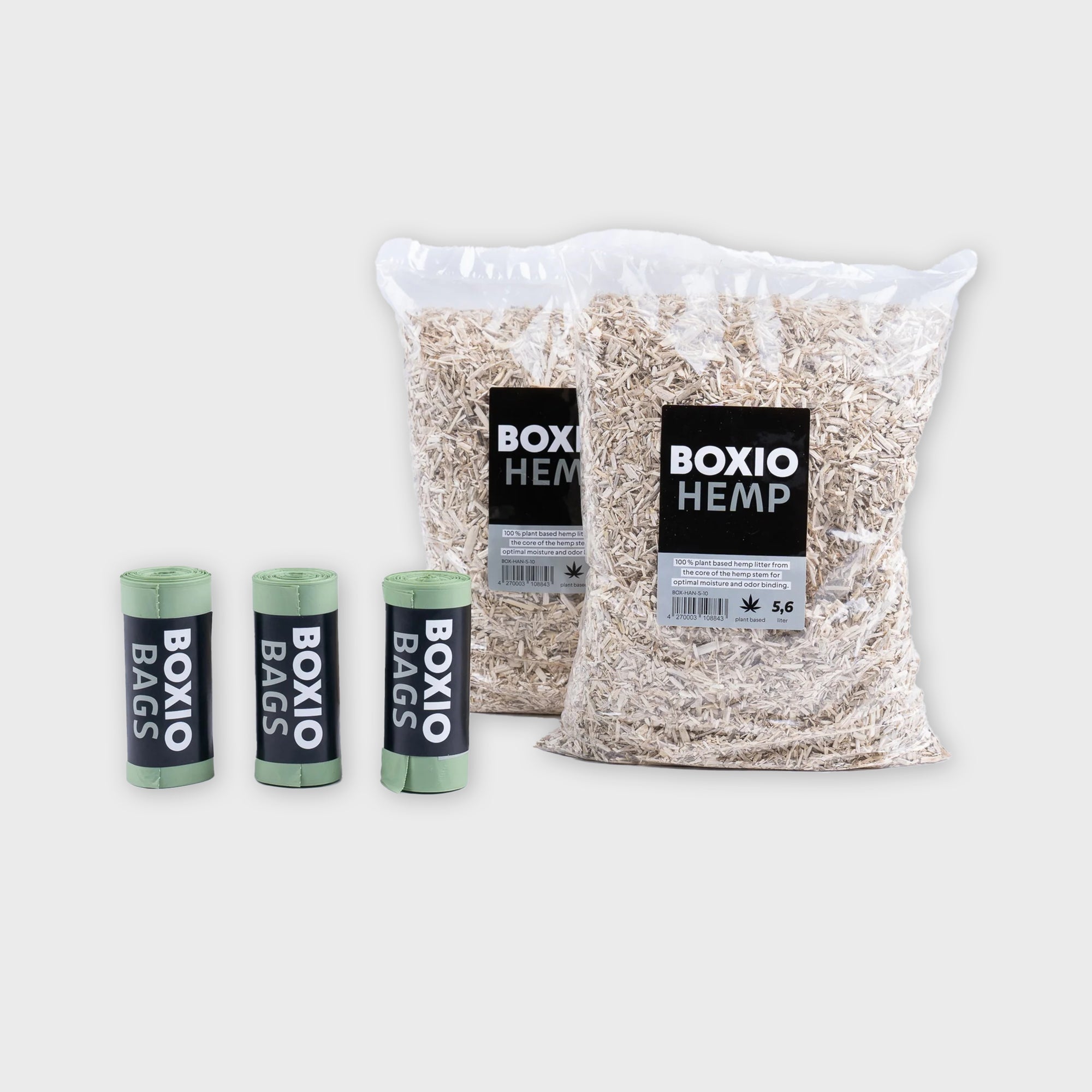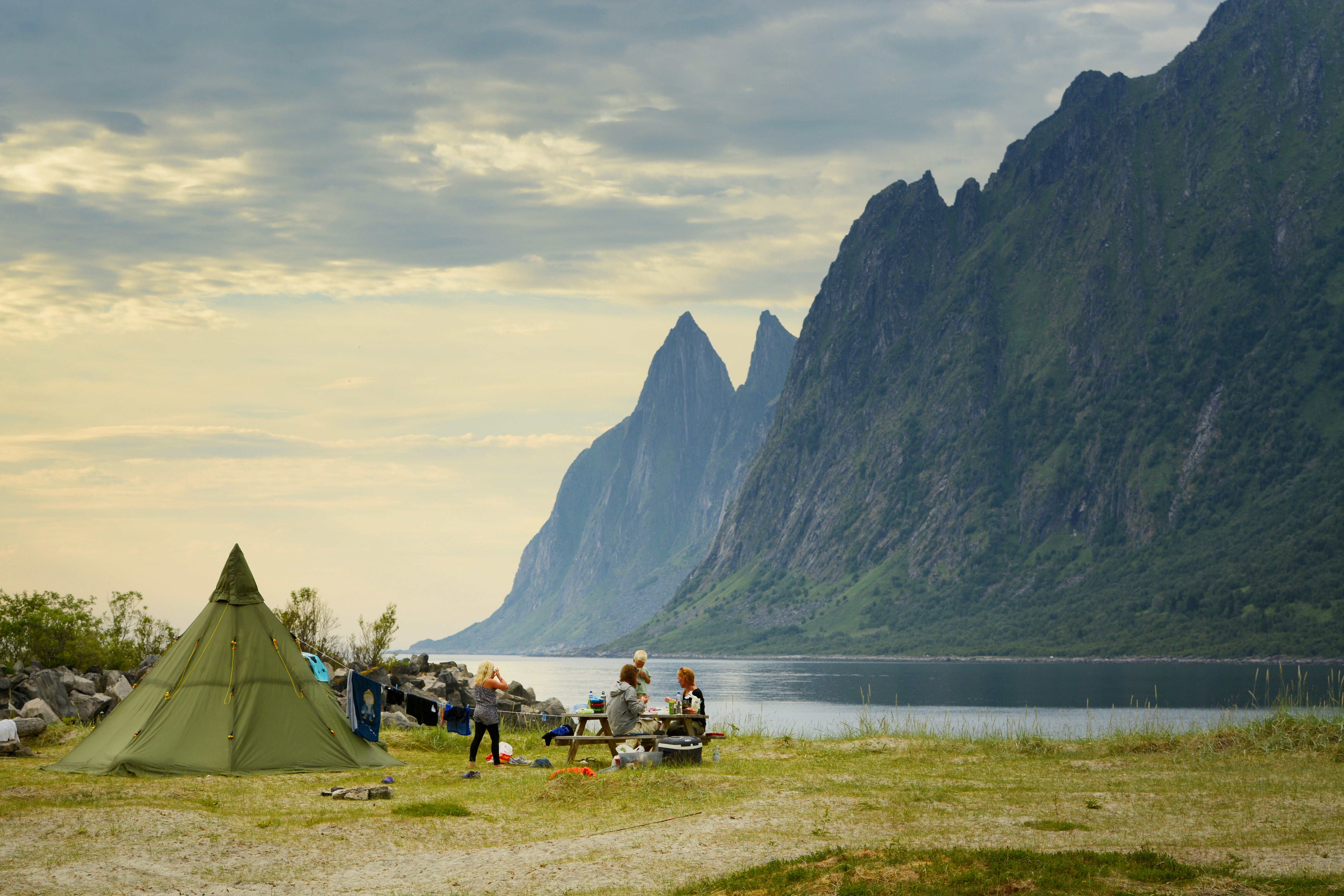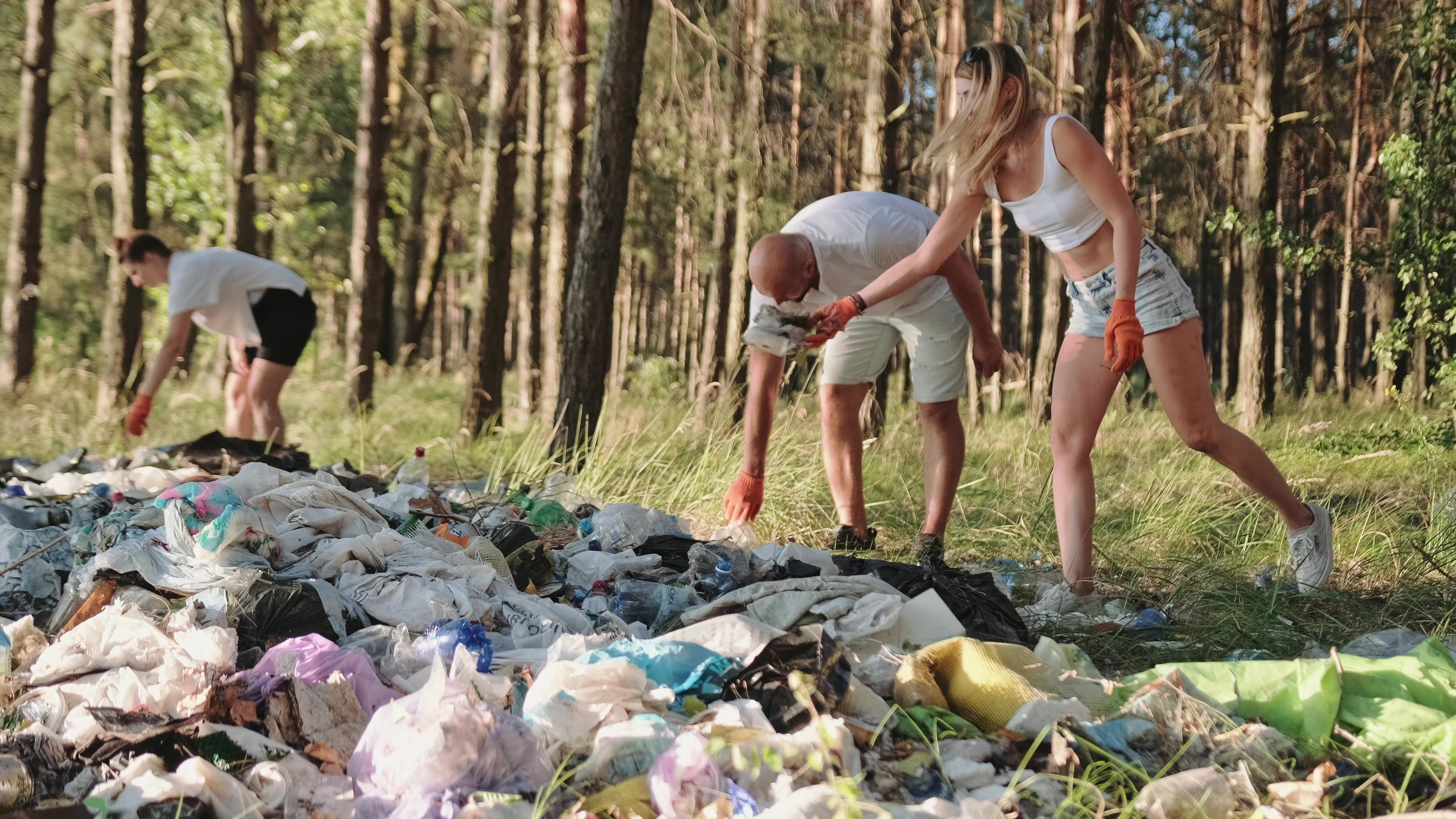Wiesn 2025 is just around the corner: the 190th Oktoberfest will take place on Munich's Theresienwiese from September 20 to October 5. Every year, over six million people flock to the largest folk festival in the world, and the festival tents, campsites and streets around Munich are correspondingly full. This is exactly when the urine-diverting toilet in the van shows its value: you remain self-sufficient, can keep to rest periods and enjoy "the freedom to be anywhere" without having to panic and search for sanitary facilities at night. Instead of standing in long toilet queues or trudging across the campsite late at night, you always have your quiet little place with you. Users report enthusiastically on how uncomplicated traveling with a urine-diverting toilet is: "Emptying turned out to be absolutely problem-free. Any public toilet (e.g. at a highway parking lot) can be used. This makes traveling with the motorhome even less complicated and a whole lot more self-sufficient." In other words: less stress, more freedom and Wiesn fun without sanitary worries.
Why a separating toilet makes the Wiesn trip more relaxed
A dry separation toilet (or separation toilet for short) separates solid and liquid waste and does not require chemicals or water. This is a particular blessing at the Oktoberfest campsite: The official sanitary facilities are overcrowded at peak times and there are strict quiet hours at night. If you are self-sufficient, you don't have to worry about the loud slamming of the camper van door at midnight. Instead, you can discreetly relieve yourself in the camper without depriving your neighbors of sleep or having to walk long distances in the dark. This not only ensures comfort, but also privacy and safety - especially if you are traveling alone or with children. Another advantage: urine-diverting toilets can usually accommodate 8-10 toilet visits before they need to be emptied. This means you don't have to keep going to disposal stations, but can stand free and independent for several days. Many campers appreciate this gain in independence: "We are overjoyed not to have to visit an emptying station all the time. Solids can go in the garbage can, liquids can be emptied in any toilet... In any case, it's been a great relief since we got the separating toilet." . Especially during the Wiesn, when parking spaces and infrastructure are at their limit, the trip is much more relaxed with a urine-diverting toilet.
Separating toilet in the van: setup, dimensions and fixing
There are various models to choose from for installing a urine-diverting toilet in a camper van. Two popular variants are the BOXIO-TOILET and the BOXIO TOILET MAX+. Both are compact, lightweight and specially designed for mobile use. The standard BOXIO measures around 30 × 40 × 28 cm and weighs only around 2.8 kg - comparable to a small Eurobox that fits in the corner of almost any van. At 40 × 38 × 30 cm (L×W×H), the larger BOXIO MAX+ offers slightly more seat height and volume and weighs around 5.2 kg . Both models are made of robust, recycled plastic and can carry loads of up to approx. 150 kg, so they can also safely carry a hearty snack eater.
When setting up in the van, you should consider a fixed location for the toilet box. A location where you can easily reach and remove it is ideal - for example, under the seat bench or in the trunk with a pull-out. Important: secure it in a non-slip position! Use anti-slip mats, tension belts or screw mounts, for example, to prevent the box from slipping during the journey. Also plan the "removal route": Can you lift the container upwards or pull it out to the front without having to dismantle everything? A hinged separator toilet insert (separator) makes access easier. The Boxio models are very well thought out here: the entire separator insert can be folded up for emptying - so you can access the inner containers quickly and cleanly. Overall, once correctly installed, the separating toilet is a low-maintenance plug-and-play appliance. After the initial assembly (approx. 5-10 minutes), no further assembly is necessary and you can also remove your portable toilet if required and use it outside (e.g. in a shower tent) - pure freedom.
BOXIO - TOILET PLUS | Composting toilet with starter set
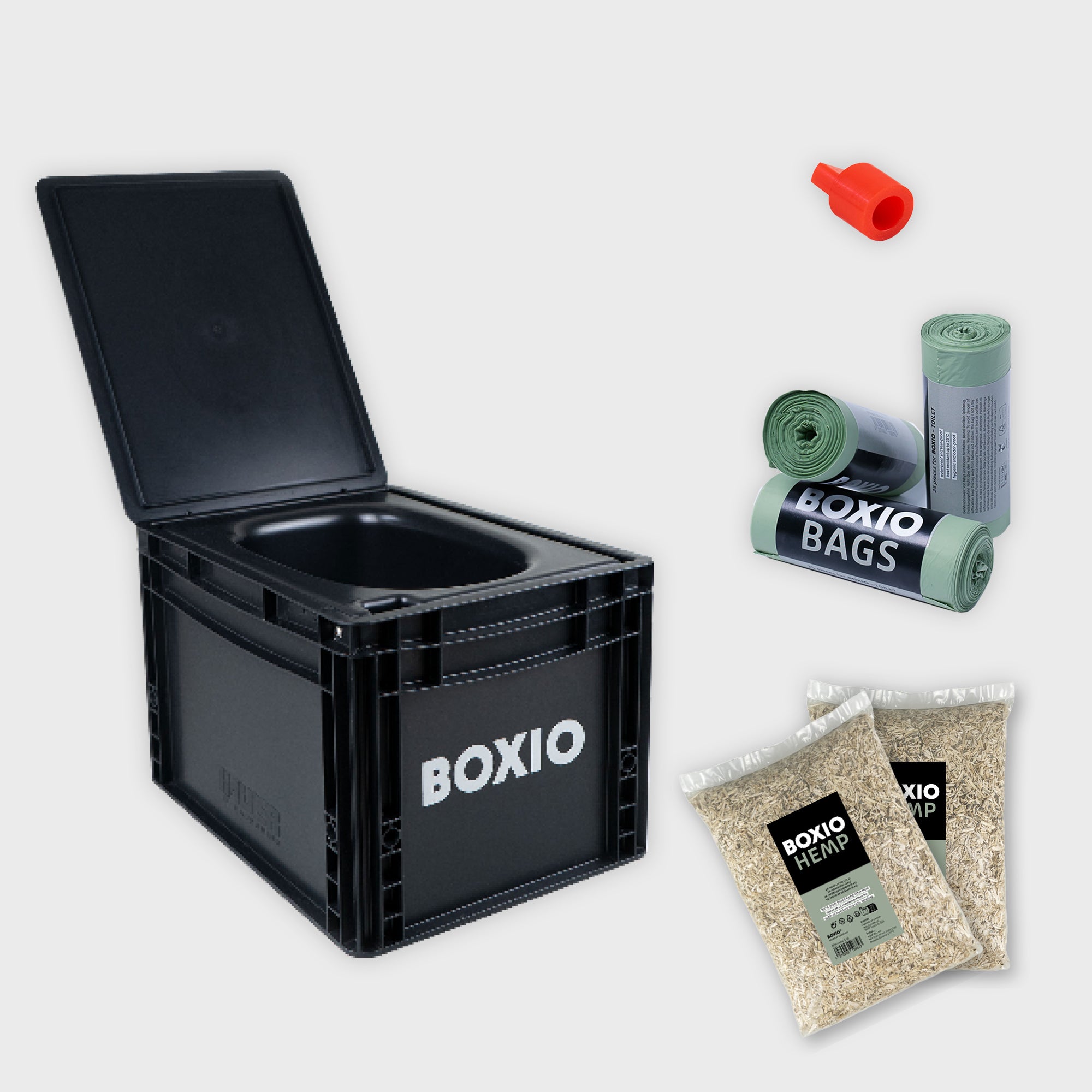
Use and emptying: the right way to do it
Operating a urine-diverting toilet is pleasingly simple, even after the third measurement 😉. Step 1: Lift the lid, drop your pants and take a seat. Thanks to the special separating insert, urine and solids automatically end up in separate containers. Just make sure you are sitting upright so that "the solids go into the potty and the droplets into the canister" - after a few attempts, you'll get the hang of it. Step 2: Do your business, with some litter (e.g. hemp litter) already in the solids container to bind moisture. Toilet paper can also be placed in the solids container. Step 3: Close the lid. Many people close the urine container after use with a lid or plug to contain odors - the BOXIO-PLUG, for example, fits perfectly on the urine canister. Step 4: After a few uses (depending on the size of the toilet, approx. 5-10 times for solids, urine containers usually have a volume of 5-8 liters), it is time to empty it. Ideally, you should not wait until both containers are full to the brim at the same time - with separating toilets, you can dispose of liquids and solids independently of each other. To empty, open the box, fold up the separator insert and remove first the closed urine canister, then the solids container (which stays clean thanks to the use of a compostable bag). Voilà! - The urine-diverting toilet is ready for the next use without spilling or getting dirty.
If you only do a little business, remember to rinse out some liquid from time to time: many vanlifers fill a spray bottle with diluted cleaning agent or vinegar and spray it briefly into the separator or urine funnel after peeing. This way, no residue remains. One user reports: "I filled a spray bottle with 20% cleaning vinegar, 2-3 sprays after each use to rinse the urine trap - 2 days collection, and I had to pull the canister and didn't smell a thing." (Translated from English). As you can see: With a few small touches, everything stays hygienic and emptying becomes a quick, mess-free to-do on your road trip agenda.
Odor and hygiene management on the road
A big issue with any camping toilet is odor. The good news is that separate toilets don't stink if you follow a few basic rules. The be-all and end-all is separation and drying. The separating insert does not mix anything that could produce unpleasant odors (the classic "chemical toilet smell" is mainly caused by the mixture of urine + faeces + chemicals). Solid excrement should be kept as dry as possible - litter helps with this. Hemp litter such as BOXIO-HEMP has proven its worth: This 100% plant-based, coarse-fibered litter material made from hemp hurds reliably binds moisture and odor. Just a thin layer of litter in the bag beforehand and one or two handfuls on top after each large transaction ensure that odors do not develop in the first place. You can also ventilate briefly after use (open the lid or, if available, operate a small fan in the box). Tip: There is also hemp bedding with added lavender, which leaves a subtle fresh scent - a matter of taste, but some people swear by it.
In addition to the right bedding, regular cleaning is important. Don't worry: you don't need any aggressive chemicals. Simple household remedies are all you need. Clean the urine container: Over time, urine scale tends to build up on the inside wall (smells like ammonia). Diluted citric acid or vinegar essence helps against this. Mix about 3 tablespoons of citric acid powder with 1 liter of water and rinse the canister with it. Leave the solution to work briefly, then pour it out - goodbye urine scale. As a prophylactic measure, you can also swirl some vinegar or citric acid with a little water around in the canister after every second emptying. Clean the solids container: As a bag is used here, the bucket usually stays quite clean. From time to time, however, you can wipe it out with mild soapy water or vinegar water. The same applies here: no harsh cleaners that attack plastics or seals. Surfaces & toilet seat: A neutral all-purpose cleaner or special toilet cleaning spray (e.g. BOXIO-CLEAN, an ecological plant-based concentrate) are ideal. These cleaners are kind to the skin, biodegradable and yet effective against odors. Many cleaners are based on natural ingredients such as citrus peel or beetroot extracts and are therefore environmentally friendly. It is important not to use anything that has a coating effect (no greasy agents, please) - this could impair the separating insert.
These simple routines will keep your urine-diverting toilet hygienically fresh on your road trip. And if you do end up with a smelly Monday afternoon: check that everything was properly separated (adjust your sitting position if necessary) and that the urine canister is tightly sealed. If in doubt, it's better to empty it once more - thanks to the simple disposal (see next section), this can be done quickly.
Disposal in the greater Munich area - What applies in D-A-CH?
Let's move on to disposal - an important point, especially if you are environmentally conscious. Basically, the following applies in German-speaking countries (D-A-CH): Solids belong in the residual waste, liquids in the sewage system. To put it plainly, you can simply knot the solid waste container lined with an organic waste bag when it is full and throw it into a normal waste garbage can - ideally residual waste (household waste). It is best to use compostable bags (e.g. BOXIO-BIO BAGS), then the package is largely biodegradable. But: Please never simply bury or scatter it in nature! Even if it says "organic" - human waste needs professional composting in order to be decomposed in a hygienically safe manner. Some urine-diverting toilet fans compost their contents in their own garden, but this requires knowledge and is hardly practical when traveling. Official recommendations say: only compost human waste in exceptional cases and with suitable systems. For the Wiesn trip, this means: make it easy for yourself and simply dispose of the bag in the bin.
Disposing of urine: Any normal toilet or sink that is connected to the sewage system is suitable here. You can, for example, pour urine into the toilet at freeway service stations (WC at the parking lot), in public toilets or at the campsite. Many vanlife experiences do just that: "So any public toilet (e.g. at the highway parking lot) can be used [to empty the urine tank]." It is important to proceed discreetly - do not "empty" in the middle of the roadside, but always pour into existing sanitary systems. Rinse with a little water and it stays clean. Where not to put it? Please do not tip into street gullies or rainwater drains - these often lead untreated into bodies of water. And of course, don't simply pour it into the bushes; concentrated urine can damage plants and cause odors.
Special case Munich: In a big city like Munich, you might expect there to be several official motorhome disposal stations. In fact, the supply is scarce: "In Munich, there is only a disposal facility at the Allianz Arena."
This means that if you are not on a campsite with a disposal station, there are hardly any legal options in the city. Many campers make do by (incorrectly) disposing of grey water in drains or emptying the toilet cassette in the toilet at home - neither of which is professional, according to the city. The Munich city council is calling for more waste disposal columns, but until these are implemented, you should plan your Wiesn trip well. Ideally, you should dispose of your waste outside the city center at freeway service stations or car parks (there are often supply and disposal stations for motorhomes). Or you can use the infrastructure of the campsites: For a fee, you can empty your cassette toilet at the municipal campsite in Munich-Thalkirchen, for example - for drivers with urine-diverting toilets, at least the only waste there is urine. The large Oktoberfest camp in Riem also has sanitary facilities for free use by overnight guests. Our recommendation: Check the local information for your pitch or municipality. Many campsites and pitches have notices indicating where the nearest disposal facility is, or allow you to empty your waste on site (sometimes for a small fee for external users). If you stick to this, you're on the safe side - and doing something good for the environment and your camper image.
Mobile bathroom as an upgrade: showers & privacy
If you are on tour for a longer period of time or traveling with family/friends, the separate toilet alone may not be enough for you. This is where the "mobile bathroom" concept comes into play. Manufacturers such as Boxio offer the BOXIO SANITARY PLUS set, for example, which contains everything you need for the bathroom and toilet on the go in two stackable Euroboxes: Separating toilet, a mobile washbasin (BOXIO-WASH) with fresh and waste water canister, mirror, shower spray and small items. The highlight is a small pop-up tent (BOXIO-TENT), which provides privacy as a shower or toilet tent. This set is your own bathroom-to-go, compactly packed in the trunk. "The BOXIO SANITARY PLUS is your mobile bathroom in just two compact and robust Euroboxes. The practical tent ensures your privacy wherever you are." So if you don't feel like queuing at the campsite or want to take a quick shower in the evening after the Oktoberfest without having to use the communal bathroom, a set like this can be worth its weight in gold. The Euroboxes also serve as a platform (you can stack them on top of each other and use them as raised seating for the toilet, for example) and as transport boxes for accessories. BOXIO-WASH uses a hand pump to provide running water for brushing your teeth or washing up. And for a quick outdoor shower, there is a shower attachment and possibly a small electronic shower head (depending on the equipment). Of course, you can also put together similar solutions yourself - but the all-in-one package is particularly practical for occasional campers.
A mobile bathroom is particularly useful for the Wiesn road trip if several people are traveling with you. This way, everyone can enjoy some undisturbed "bathroom time" without having to send fellow travelers away. Getting ready in the morning in your own tent instead of in the usually overcrowded and perhaps not very clean camping shower - that sounds tempting. Incidentally, the mobile bathroom systems are completely self-sufficient: no electricity, no waste water connection required. Perfect for a simple pitch or a festival camp where nothing is provided apart from a parking space.
BOXIO SANITARY PLUS | Mobile bathroom with TENT

Packing list and little emergency helpers
Before you set off for Munich, you should go through a small packing list in your head so that everything runs smoothly when it comes to the urine-diverting toilet. Here are the essentials:
-
Spare bags (bio bags): Calculate how many "big deals" you might have to do and take enough compostable urine-diverting toilet bags with you. If in doubt, pack a few more - they weigh and cost hardly anything.
-
Sufficient bedding (e.g. BOXIO-HEMP hemp bedding): Nothing is worse than odor due to a lack of litter. Experience has shown that a 5-liter bag of hemp litter is enough for about 10-15 toilet visits. For a week at the Oktoberfest with two people, plan perhaps 1-2 bags, depending on usage.
-
Gloves & household wipes: Disposable rubber gloves are practical for emptying, especially if you don't have a water supply to wash your hands thoroughly when you're out and about. A few all-purpose cleaning cloths or some kitchen roll never hurt either - for wiping, wiping, wiping your mouth after a chicken meal 😉 etc.
-
Cleaner & spray bottle: Pack a small spray bottle (e.g. 0.5 L) with your favorite cleaner. This can be BOXIO-CLEAN or simply a mixture of water and vinegar (1:7) or citric acid solution. You can use this to rinse after urinating and clean in between.
-
Replacement toilet paper: Sounds trivial, but remember - you can use normal household toilet paper, which goes into the solid waste container. If you want to be particularly environmentally friendly, use unbleached recycled paper. In any case, it's better to have an extra roll with you in case your camping neighbor suddenly wants to "borrow" it.
- Plan B for micro-emergencies: If something does go wrong (e.g. you lose the cap on the urine canister or the bag tears), have a few zip bags and some cat litter to hand. Zip bags can be used improvised as tight garbage bags for smaller amounts, cat litter binds puddles of urine. It's rarely necessary, but when it is, you'll be glad of it!
With this equipment, you'll be equipped to deal with unforeseen situations with confidence. And remember: ideally, you should leave the spot cleaner than you found it. This means taking away or disposing of all waste (including cigarette butts, bottle caps, etc.), leaving no "liquid waste" in the countryside and generally behaving in such a way that other campers and residents are not disturbed. Especially in the highly competitive Oktoberfest camping season, good cooperation is important.
Leave-No-Trace: Pitch etiquette for Oktoberfest campers
Leave No Trace - the unwritten rule for all outdoor enthusiasts. For your Oktoberfest road trip, this means: behave on pitches and in nature in such a way that no negative impression is left behind. Specifically:
-
No wild dumping: As emphasized above, do not dump anything illegally in the countryside. Munich is already struggling with the consequences of some people simply letting their gray water run into the sewage system - don't join in. Use official channels.
-
Respect the peace at night: Most campsites go quiet at night from around 10 pm. Thanks to separate toilets, you don't have to walk around the site at night - but it should also be quiet in the van (no loud music, slamming doors, etc.). In Munich, these rules are strictly enforced, as local residents pay close attention to them.
-
Keep your parking space clean: Keep your area tidy. Especially if you are camping "in the garden" of the city, such as in Thalkirchen (300 pitches directly on the Isar), consideration is important. So collect garbage and don't leave anything lying around. Pro tip: A small broom and dustpan to sweep crumbs or dirt out of the van helps to ensure that nothing falls out and is left lying around.
-
Be friendly and exemplary: Campers are basically a community. Help out your tent neighbor when he comes back from the shower and notices that his tent is flying away. Share information (e.g. where the nearest waste disposal station is) with less experienced vanlifers. If everyone looks out for each other, the Wiesn trip will be better for everyone.
- Park only where permitted: There are no parking facilities for motorhomes around the Festwiese, and wild parking is punished with high fines, especially during Oktoberfest. So plan your parking space in advance. The city of Munich clearly recommends: "Please use Munich's campsites during the Oktoberfest and reserve your parking space in advance." Without a reservation, little is possible - with the exception of the large Riemer Camp, where you can also arrive spontaneously if necessary. Therefore: be a good planner, not a parker in illegal spots.
If you follow this etiquette, you will not only be stress-free yourself, but also help to ensure that camping is still welcome in Munich. In the past, there have been initiatives to create more official pitches, but also criticism because a few black sheep have misbehaved. So let's show together that vanlife and Oktoberfest are compatible - clean, considerate and in a good mood!
FAQ: Frequently asked questions about the separation toilet at Oktoberfest
Which BOXIO toilet is right for the Oktoberfest trip?
The BOXIO-TOILET is ideal for couples or solo travelers with little space - compact (approx. 30×40×28 cm) and ultra-light (2.8 kg). If you want a little more seat height and volume (e.g. families), opt for the BOXIO TOILET MAX+ with 40×38×30 cm and approx. 5.2 kg . Choose according to the available storage space and number of people.
How do I dispose of waste correctly when traveling?
In Germany, Austria and Switzerland (D-A-CH) the following applies: Solids in the residual waste, liquids in official sanitary facilities. In other words, put the solid waste bag tightly closed in a garbage can (compost only in exceptional cases and only with compostable bags, but this is usually not ideal). Always dispose of urine in toilets or motorhome disposal stations - never in the countryside. Tip: Public toilets at rest stops are ideal for emptying the urine canister. In Munich, it is best to use the campsites or the station at the Allianz Arena, as there are hardly any other options.
What do I need against odors?
BOXIO-HEMP hemp litter has proven its worth as bedding. It neutralizes odours by binding moisture. Simply add some litter after every "big business". Air the toilet briefly in between (open the lid) and close the urine tank with a lid or plug. BOXIO-CLEAN cleaning concentrate or a mild cleaner (pH-neutral) is sufficient for maintenance. Diluted vinegar or citric acid (e.g. 3 tablespoons to 1 liter of water) are also suitable for cleaning the separating insert and containers.
Is there a complete bath for the road trip?
Yes, with the BOXIO SANITARY PLUS bundle you get a mobile bathroom in two Euroboxes - including a urine-diverting toilet, mobile washbasin and shower accessories as well as a privacy tent. Ideal if you are traveling with friends or family and want to enjoy showering/washing in privacy. The set is designed so that you are independent of external connections (no electricity/water required). Alternatively, you can also put together something similar yourself with a toilet, jerry can and shower tent. The important thing is that you are completely self-sufficient and avoid queues at the showers on the campsite.
Good luck and have fun at the Wiesn, it's easy with the urine-diverting toilet!



